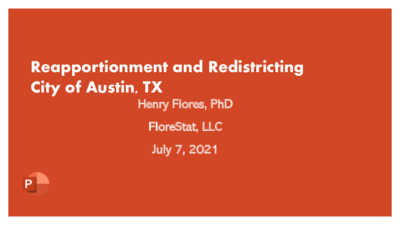Item2A-ICRC-Austin, TX-(H.Flores).pdf — original pdf
Backup

Reapportionment and Redistricting City of Austin, TX Henry Flores, PhD FloreStat, LLC July 7, 2021 Rationale for Reapportionment and Redistricting Constitutional and Voting Rights Requirements Reapportionment every ten years Based on Census Reports Reapportionment Every ten years, immediately after census, must determine the amount of population growth or loss in each city council district. All districts must be within a +/- 10% deviation from the most to least populated district to insure one-person/one-vote constitutional requirement. Census Data Basis of population numbers. Total city population/number of districts = population per district. There cannot be more than a 10% population deviation from the largest to the smallest district. Changes in Total Population 2000-2019 Total 2000 2010 %∆ 2019 %∆ 689,701 798,962 13.7 979,263 18.4 Since 2000 Austin has grown by almost 300,000 persons. Growth Changes per City Council District 2000 - 2010 District %Inc/Dec 1 2 3 4 5 6 7 8 9 10 2000 65,313 60,949 75,789 78,810 66,365 54,535 75,798 53,597 81,484 77,061 2010 77,807 80,004 79,573 79,357 81,532 82,389 80,520 77,650 79,299 80,839 19.1 31.3 5 .7 22.9 51.1 6.2 44.9 -2.7 4.9 It is not clear if these growth changes were due to normal demographic occurrences or the result of the 2010 redistricting. The data do indicate that some districts have grown dramatically while others have shown smaller growth or even negative growth. 2019 data were not available too make further comparisons. Change in Minority Pop 2000 - 2010 Race 2000 2010 %∆ Anglo 367,398 390,302 Black 65,804 61,310 5.9 -6.8 Hispanic 209,663 279,713 25 Asian 32,919 53,908 38.9 Minority pops have grown dramatically from 2000-2010. Do not have projections for 2019 but its possible that Austin may be a minority majority city after 2020 census released. This will affect all city council districts. Decisions to be Made 1. Redraw districts using new population ratios. (Lawyers). 2. Leave district boundaries as they are. May get sued. 3. Add more districts. (Lawyers). 4. Change electoral system: mixed (at-large/single member) or at- large, place system. (Lawyers).